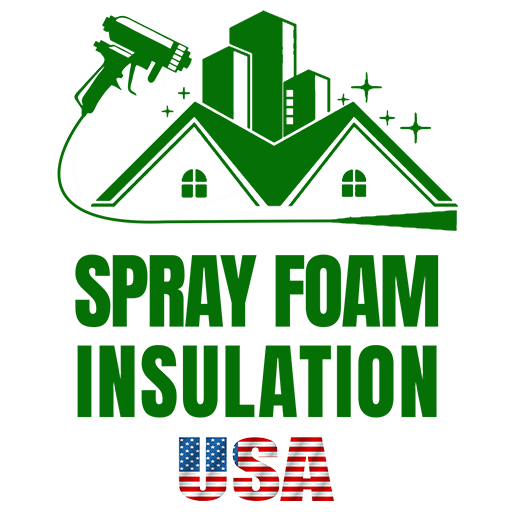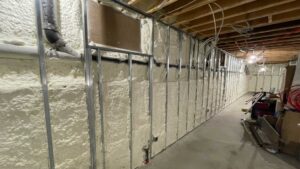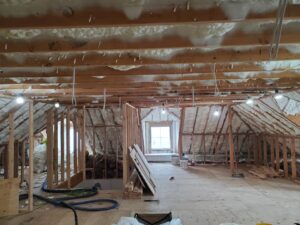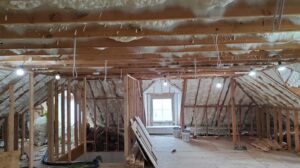If you’re wondering “how do I insulate an attic?”, you’re already on the right path to enhancing your home’s energy efficiency and comfort. Insulating your attic is a key step in reducing your heating and cooling costs, maintaining a comfortable temperature year-round, and contributing to a healthier environment. With the right approach, you can save money on energy bills and enjoy a more consistent indoor climate.
Attics play a crucial role in your home’s overall energy performance. Proper insulation in this space can prevent heat loss in winter and keep your home cooler in summer, leading to significant energy savings. It’s not just about adding material; it’s about choosing the right type of insulation, ensuring it’s correctly installed, and complementing it with a radiant barrier if needed to maximize efficiency.
Understanding the basics of attic insulation can seem daunting, but it boils down to a few simple principles: sealing air leaks first, choosing insulation with the appropriate R-value for your climate, and making sure not to block ventilation. These steps will lead you to not only save on your energy bills but also improve the comfort and value of your home.

With Spray Foam Insulation USA, you’ll find all the expertise and high-quality materials needed to make your attic insulation project a success, whether you’re a DIY enthusiast or prefer to leave it to the professionals.
Choosing the Right Insulation for Your Attic
When it comes to insulating your attic, the options can feel overwhelming. But don’t worry, we’re here to break it down into simple choices that will make your decision easier. The right insulation can not only save you money on energy bills but also improve the comfort and value of your home. With Spray Foam Insulation USA, you have access to top-notch materials and guidance.
Types of Insulation
There are three main types of insulation you should consider for your attic:
-
Fiberglass Batt Insulation: This is the fluffy, pink or yellow stuff you often see. It’s easy to handle and great for DIY projects. It comes in rolls that you can cut to fit the spaces between your attic joists.
-
Blown-In Insulation: This can be either fiberglass or cellulose. Professionals use a machine to blow these small particles into your attic, filling every nook and cranny. It’s excellent for covering irregular spaces and for adding insulation on top of what’s already there.
-
Spray Foam Insulation: This is a high-performance option that expands to fill gaps, providing excellent air sealing and moisture protection. It’s applied as a liquid that quickly expands and hardens into a solid foam.
R-Value: What You Need to Know
R-value measures how well insulation can resist heat flow. The higher the R-value, the better it insulates. Here’s the simple rule: choose insulation with a high R-value. But keep in mind, the recommended R-value for your attic depends on where you live.
Climate Considerations
Your local climate plays a big role in choosing the right insulation. Here are some general guidelines:
- Cold Climates: Look for insulation with a higher R-value to keep the warmth in during winter.
- Warm Climates: Insulation with a good R-value is still important to keep your home cool, but you might also consider a radiant barrier to reflect heat away.
- Mixed Climates: Focus on a high R-value and consider adding a radiant barrier if your attic gets a lot of sun exposure.
Insulating your attic is not just about keeping warm or cool; it’s about creating a comfortable, energy-efficient home year-round. With the right insulation, you can achieve that cozy feeling in the winter and a cool retreat in the summer, all while saving money on your energy bills.
With Spray Foam Insulation USA, you’ll find all the expertise and high-quality materials needed to make your attic insulation project a success, whether you’re a DIY enthusiast or prefer to leave it to the professionals.
DIY Attic Insulation: A Step-by-Step Guide
Insulating your attic is a smart move for energy savings and home comfort. If you’re ready to tackle this project yourself, here’s how to do it right. Safety first, preparation is key, and sealing air leaks is crucial.
Safety Gear
Before you start, gear up for safety:
- Gloves: Protect your hands from sharp objects and insulation materials.
- Goggles: Keep your eyes safe from dust and fibers.
- Mask or Respirator: Avoid inhaling insulation particles.
- Long Sleeves and Pants: Insulation can irritate your skin, so cover up.
Preparing the Attic
Clear the space:
- Remove stored items: Your attic needs to be accessible.
- Lighting: Ensure you have enough light to see clearly.
- Ventilation: Keep the area well-ventilated to avoid inhaling dust or fibers.
Sealing Air Leaks
Air leaks can undermine your insulation efforts. Here’s how to seal them:
- Identify leaks: Common spots include around light fixtures, wiring, and pipes.
- Use caulk and foam: Small gaps can be sealed with caulk, while expanding foam works well for larger spaces.
- Don’t forget the attic hatch: This is a prime spot for leaks, so make sure it’s well-sealed.
Pro Tip: Always start in the furthest corner of the attic and work your way back to the entrance. This way, you won’t accidentally cover up or compress the insulation you’ve just laid down.
By following these steps, you’ll ensure your attic is well-insulated, which can lead to significant energy savings and a more comfortable home. The key to successful DIY attic insulation is preparation, safety, and attention to detail. With Spray Foam Insulation USA, you have access to top-quality materials and expert advice to guide you through your DIY project.
Next, we’ll look at some common mistakes to avoid when insulating your attic, ensuring your hard work pays off in energy savings and home comfort.
Common Mistakes to Avoid When Insulating Your Attic
When tackling the task of insulating your attic, it’s easy to fall into a few common traps. These mistakes can not only make your insulation less effective but can also lead to bigger problems down the line. Let’s dive into what these are and how you can avoid them.
Neglecting Air Seals
Air sealing is like the hidden hero of attic insulation. Without it, you’re letting warm or cool air escape, which means all that insulation isn’t doing its job properly. Think of it this way: Insulating your attic without air sealing is like wearing a woolly sweater on a windy day without a windbreaker. The air just cuts right through.
How to avoid it? Before you lay down any insulation, hunt for leaks. Common culprits include around light fixtures, wiring holes, and along the attic floor. Seal these up with caulk or spray foam. It’s a simple step that makes a big difference.
Compressing Insulation
More isn’t always better, especially when it comes to insulation. If you compress it, you’re squishing out the air pockets that make it effective. This is a common mistake when trying to stuff too much insulation into a space or when storing items on top of it.
How to avoid it? Be gentle with your insulation. Spread it evenly and resist the urge to walk on it or use it as a storage platform. If you need to store items in the attic, consider building a raised platform over the insulation to protect its integrity.
Blocking Ventilation
Your attic needs to breathe. Proper ventilation keeps air circulating, which helps prevent moisture buildup and regulates temperature. Blocking vents with insulation is a mistake that can lead to mold, mildew, and roof damage.
How to avoid it? Keep a clear path for air to move in and out of your attic. Make sure soffit vents are not covered and that there’s enough space for air to flow freely. Sometimes, adding baffles (vent chutes) can help maintain proper airflow.
By steering clear of these common pitfalls, you’re setting yourself up for success. Insulating your attic is a smart move for energy savings and comfort, but doing it right is key. With these tips in mind, you’re well on your way to making your home more energy-efficient and cozy, no matter the season. Spray Foam Insulation USA is here to help with quality materials and expert advice whenever you need it.
Next, we’ll explore whether tackling insulation as a DIY project is the best choice for you or if hiring professionals might be the way to go.
Professional vs. DIY Insulation: What’s Best for Your Home?
Deciding between DIY and professional insulation for your attic can feel like weighing apples against oranges. Both have their merits, but it comes down to a few key factors: cost comparison, time investment, and professional expertise. Let’s break these down to help you make the best decision for your home.
Cost Comparison
DIY Route: Initially, it seems less costly. Buying materials and handling the labor yourself means you’re not paying for professional installation. However, hidden costs can emerge. Mistakes due to inexperience can lead to wasted materials or even the need to redo the job. Plus, specialized tools required for the job might add up.
Professional Installation: The upfront cost is higher, no doubt. You’re not just paying for materials but also for the expertise and labor of experienced installers. The advantage here is that professionals can often get materials at a lower cost and have the right tools and equipment, which can offset some of the higher labor costs.
Time Investment
DIY: Insulating an attic isn’t a one-hour TV show makeover. It requires significant time, from planning to execution. If you’re new to DIY insulation, expect to spend time researching, purchasing materials, and actually doing the work, which can extend over several weekends.
Professional: Hiring a pro transforms the time you’d spend working into time you can use elsewhere. Professionals can complete the job in a fraction of the time it would take a DIYer, thanks to their experience and team size.
Professional Expertise
DIY Knowledge Gap: While there’s a wealth of information available, there’s no substitute for experience. Professionals understand building codes, how to navigate tricky attic spaces, and how to maximize energy efficiency. They can spot issues a DIYer might miss, like mold or air leaks, and address them properly.
Professional Perks: Beyond just installing insulation, professionals can provide advice on the best type of insulation for your climate and specific needs. They ensure that the job is done right the first time, avoiding costly mistakes or inefficiencies that could impact your home’s energy bills.
Making Your Choice
When to DIY: If you have experience with home improvement projects, access to the necessary tools, and time to dedicate to the project, DIY attic insulation can be a rewarding and cost-saving endeavor.
When to Hire Professionals: If you’re unsure about your ability to insulate your attic effectively, value your time, and prefer a guarantee that the job is done right, professional installation is the way to go. It’s especially recommended if your attic has complex features or if you’re looking for the peace of mind that comes with professional expertise.
In conclusion, whether you choose the DIY route or decide to hire professionals, the key is ensuring that your attic is properly insulated to improve your home’s energy efficiency and comfort. Spray Foam Insulation USA is here to support your insulation needs with expert advice and quality materials. Making the right choice for your home will save you energy and money in the long run, enhancing your living space for years to come.
Frequently Asked Questions about Attic Insulation
When it comes to insulating your attic, homeowners often have a lot of questions. Let’s tackle some of the most common ones to help you make informed decisions on how to best insulate your attic space.
Can I install new insulation over old?
Yes, in many cases, you can install new insulation over old insulation, but there are a few things to keep in mind. First, ensure the existing insulation is not wet, moldy, or otherwise damaged. If it is, it should be removed and replaced rather than covered. Also, be mindful of the material. For example, if you’re adding loose-fill insulation on top of batt insulation, make sure it doesn’t compress the batts, as this can reduce their effectiveness.
Should I insulate the attic floor or rafters?
The choice between insulating the attic floor or the rafters depends on how you plan to use the attic. If your attic is just for storage and not a living space, insulating the attic floor is the best option. This method keeps the living spaces below warm or cool, saving on energy costs. However, if you’re converting your attic into a living space, you’ll want to insulate the rafters to make the attic itself comfortable. This approach is more involved and costly but necessary for a livable attic space.
How much does attic insulation cost?
The cost of attic insulation varies widely based on the size of your attic, the type of insulation you choose, and whether you hire professionals or do it yourself. On average, homeowners can expect to spend anywhere from $1 to $7 per square foot. Doing the job yourself can save on labor costs, which typically run between $440-680. However, the total cost will also depend on the insulation material. Fiberglass, cellulose, and spray foam have different prices and efficiency levels, so choose the one that best fits your needs and budget.
While upfront costs may seem high, the long-term savings on your energy bills can be significant. Proper attic insulation not only reduces your energy costs but also improves the comfort of your home, making it a wise investment.
In conclusion, whether you’re tackling attic insulation as a DIY project or hiring professionals, it’s important to weigh the costs, benefits, and your specific needs. Spray Foam Insulation USA is here to help, offering expert advice and quality materials to ensure your attic insulation project is a success. With the right approach, you can enhance your home’s energy efficiency and comfort for years to come.
Conclusion
As we wrap up our guide on attic insulation, let’s highlight the key takeaways about energy efficiency, home comfort, and how Spray Foam Insulation USA can play a pivotal role in enhancing your living space.
Energy Efficiency: A well-insulated attic is a cornerstone of an energy-efficient home. By preventing heat loss in winter and heat gain in summer, attic insulation helps maintain a comfortable indoor temperature year-round. This not only reduces the strain on your HVAC system but also leads to significant savings on energy bills. A higher R-value means better insulation, which translates to greater energy efficiency.
Home Comfort: Insulating your attic goes beyond just savings; it’s about creating a consistently comfortable environment for you and your family. No more hot or cold spots—just smooth, stable temperatures that make your home a more pleasant place to live. From reducing outside noise to minimizing the chances of ice dams on the roof, the benefits of a properly insulated attic extend well into home maintenance and care.
At Spray Foam Insulation USA, we understand the importance of a well-insulated attic. We’re dedicated to providing top-notch insulation solutions that cater to your specific needs. Whether you’re looking to tackle a DIY project or prefer the expertise of professionals, we’re here to support you every step of the way.
Choosing Spray Foam Insulation USA means opting for quality, efficiency, and peace of mind. Our products are designed to offer the best in insulation technology, ensuring that your home remains energy-efficient and comfortable throughout the seasons. Plus, our team of experts is always ready to offer advice, help you select the right materials, and guide you through the installation process.
In conclusion, insulating your attic is one of the most effective ways to enhance your home’s energy efficiency and comfort. With the right materials, a bit of know-how, and support from Spray Foam Insulation USA, you can ensure that your attic insulation project is a resounding success. Ready to improve your home’s insulation? Contact us today for a free estimate and let’s make your home the best it can be.





